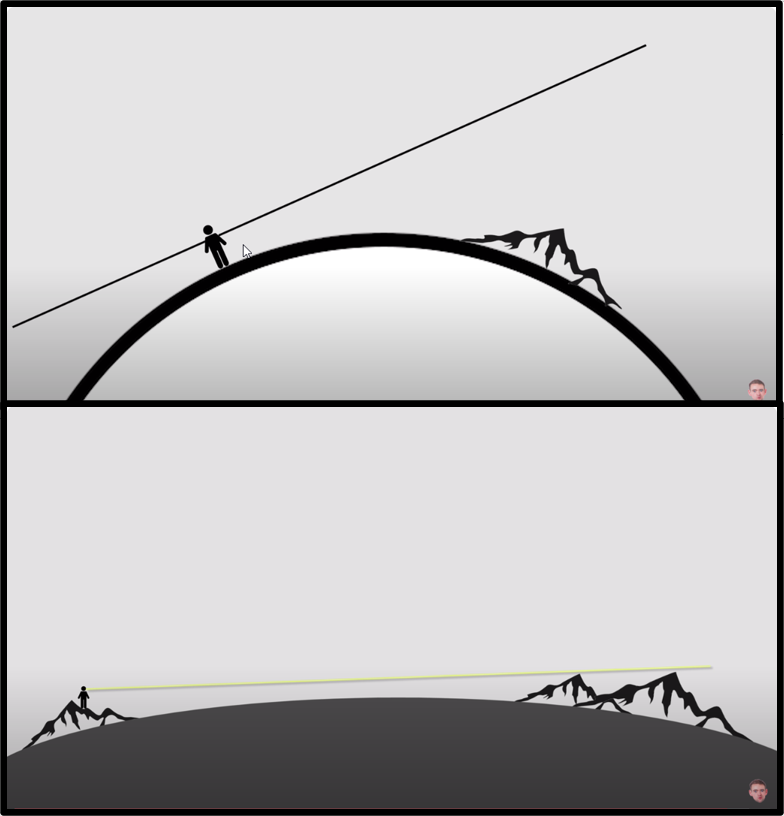STORY UPDATED: check for updates below.

Do long-distance photos, showing things up to hundreds of miles away, provide evidence that the Earth is not curved? No, that's not true: Photos of faraway objects might appear flat because of Earth's large size, not because Earth itself is flat. While the Earth's surface does curve in these photos, it may not be noticeable due to the vast scale of the planet and the topography in any given area.
The claim appeared in a video (archived here) on TikTok by alphaandomega985 on March 18, 2024. The video's description said:
This is what the post looked like on TikTok at the time of writing:
(Source: TikTok screenshot taken on Tue Mar 26 15:06:36 2024 UTC)
The video
During the 65-second clip, the narrator laid out his claim that long-distance photography on Earth proves the planet is flat. Here's what he said:
... The No. 1 reason why a lot of people are waking up to the truth of flat Earth is the Nikon Coolpix P1000. This camera is the most powerful zoom in the world. ... The No. 1 proof besides people who believe in the Bible for flat Earth is the fact that you can see way too far.
The reason why this camera is being discontinued is because they do not want normal people going out there like me who can go out there and zoom in on miles and miles and miles and see absolutely zero curvature.
Earth is huge (compared to us)
It's easy to see why people might believe the Earth is flat because that's what it looks like from our vantage point on the ground. At 24,901 miles around at the equator, it's tough to see enough of the planet to tell that it's curved. An article (archived here) from the University of Nevada, Las Vegas (UNLV) titled "Round Earth Clues: How Science Proves that our Home is a Globe" explains why:
The misconception that the Earth must be flat because it looks flat to us arises simply because the Earth is big. The height of an adult is much less than one millionth of the Earth's radius. In order to see the curvature of the Earth in a single field of view, you would need to be perched above the surface a sizable fraction of that radius, and one millionth wouldn't be considered 'sizable.'
The UNLV article also offers another example of how the Earth is curved and a big ball:
Hop on a plane, and fly to Cape Town, South Africa, or Melbourne, Australia -- two major cities located in the Southern Hemisphere. There, you won't be able to see the North Star.
By the same token, the night sky appears different depending on what part of the world you're in. That wouldn't be the case if the world were flat. It would essentially be the same for every location.
In a March 27, 2024, email, Jason Steffen, the article's co-author and an assistant professor of physics at UNLV, told Lead Stories there are other examples showing the curvature of the Earth:
You probably could see the curvature of the Earth with this lens [in the video] if you were to watch a ship going out to sea. The ship would slowly sink below the horizon as it got further and further from the shore.
Land-based images are not the best option for seeing the effects of the Earth's curvature because the ground is not level. In order to see the curvature, you would need to observe a distance that is a reasonable fraction of the radius of the Earth (like a percent or so--so, several to a couple dozen km [kilometers]).
There aren't many places on the Earth where the ground is sufficiently level for such a distance.
Steffen also offered this picture (archived here) on Reddit as evidence of the curvature of the Earth:
(Source: Reddit screenshot taken on Wed Mar 27 15:06:36 2024 UTC)
Additionally, a person's height above the sea level impacts how far they can see. The closer you are to the ground, the more quickly something will disappear from your view. Whereas, if you were on a mountaintop, you could potentially see another mountaintop a few hundred miles away if the conditions were right.
World record long-distance picture
The Guinness World Record (archived here) for "Longest line of sight on earth photographed" is 275 miles from Pic de Finestrelles, Spain, to Pic Gaspard, France, on July 13, 2016. The Guinness website said this about the feat:
There are very few places on earth where it is possible to extend the line of sight so far. Due to the curvature of earth, both the observer and object must be at sufficiently high altitudes for the object to be visible at long range. The higher an observer is, the further they may see before the point where the earth curves out of sight, otherwise known as the horizon. If the earth had a uniform radius with no mountains and valleys, an individual six feet in height would view the horizon to be 5 km [3.1 miles] away from them.
The following visuals from a video (archived here) published on YouTube titled "Flat Earth 'evidence' That SHOWS CURVATURE" help illustrate the point:
(Source: YouTube screenshots taken on Tue Mar 26 2024 UTC)
Other illustrations
These examples and a few others can be found in this video (archived here) by MinutePhysics called "TOP 10 REASONS Why We Know the Earth is Round":
Nothing new
The Earth being a globe is not a new concept, to say the least. It's been around for a couple of millennia. The NASA website (archived here) offers these details from the article "What Is Earth?":
Humans have known that Earth is round for more than 2,000 years! The ancient Greeks measured shadows during summer solstice and also calculated Earth's circumference. They used positions of stars and constellations to estimate distances on Earth. They could even see the planet's round shadow on the moon during a lunar eclipse. (We still can see this during lunar eclipses.)
Today, scientists use geodesy, which is the science of measuring Earth's shape, gravity and rotation. Geodesy provides accurate measurements that show Earth is round. With GPS and other satellites, scientists can measure Earth's size and shape to within a centimeter. Pictures from space also show Earth is round like the moon.
Read more
Other Lead Stories fact checks of flat Earth claims can be found here.
Updates:
-
2024-03-27T20:37:43Z 2024-03-27T20:37:43Z Adds context from University of Nevada, Las Vegas professor Jason Steffen.
















